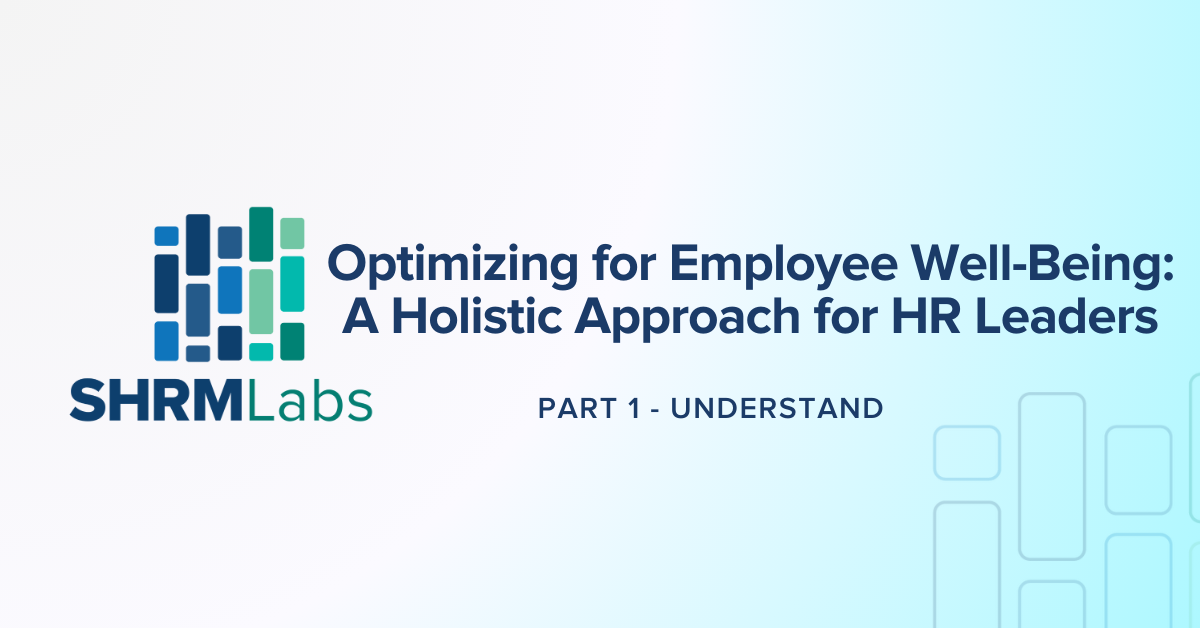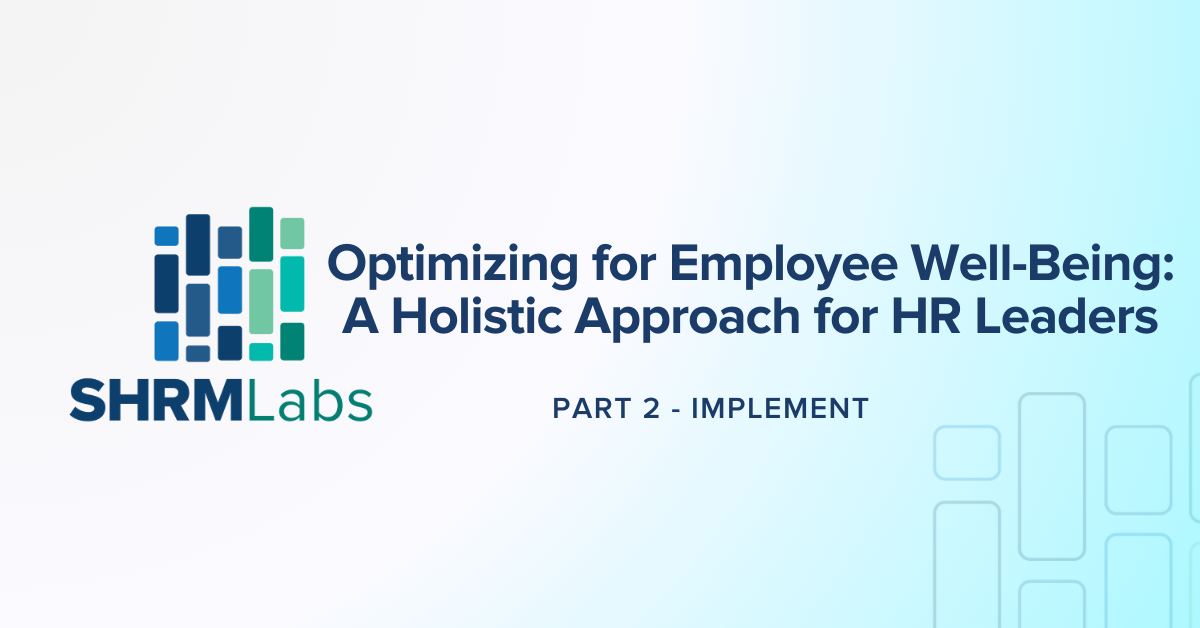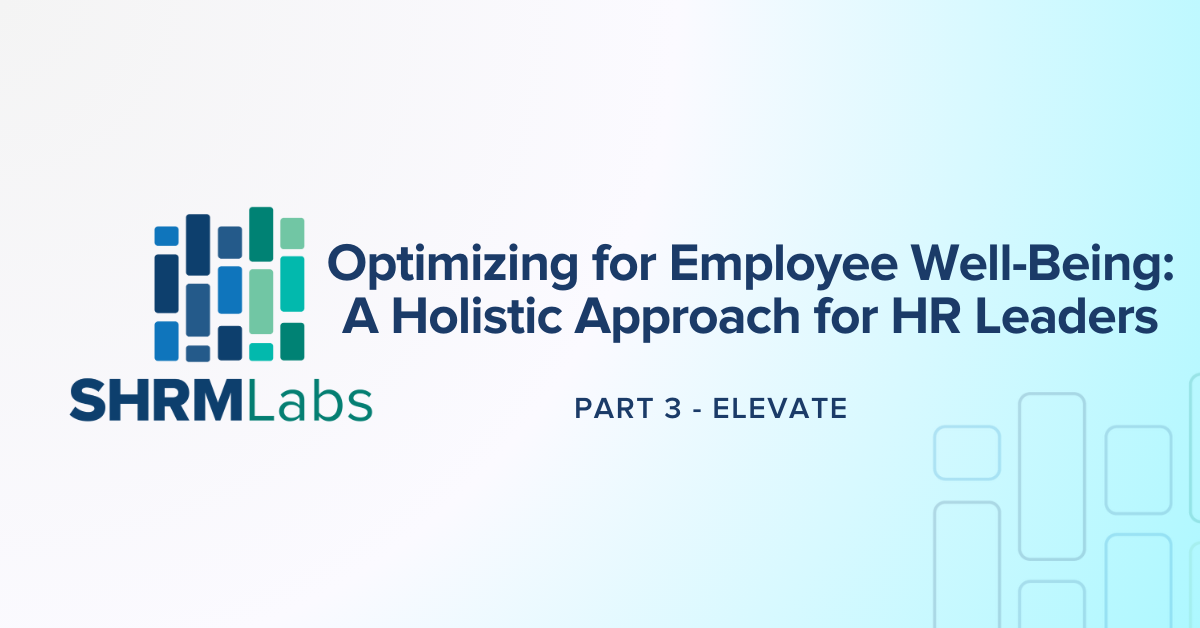Operationalizing Feedback
Using Real-Time Input To Guide Everyday Business, Not Just Performance Reviews
Before we begin…
Welcome to the WorkplaceTech Pulse, presented by SHRM Labs. We are expanding our resources to bring you the best possible information from leaders in HR technology and transformation.
My name is Nell Hellem, innovation catalyst at SHRM Labs. You will hear from me as well as my colleagues every other week with the release of each new edition. Let us know any topics you’d like to hear about related to workplace tech and we will consider them for future editions of the WorkplaceTech Pulse.
Introduction
Traditional feedback systems in organizations often fall short due to their siloed, retroactive, and infrequent nature. This framework can lead to negative emotional responses from employees, delays in feedback processing, lack of actionable insights, and a generally poor user experience with commercial tools. Additionally, the growing presence of Generation Y and Generation Z in the workforce, along with widespread “app overload,” exacerbates these issues. To move forward, it’s essential to shift from retroactive feedback to an operational input model, where real-time, low-friction feedback mechanisms are integrated into daily workflows, benefiting both employees and organizations.
I’m excited to introduce this edition’s contributor, Ansel Duff, founder of Fordi. Ansel, over to you!
Thanks for having me, Nell! My name is Ansel and I run Fordi, an AI-powered software platform offering real-time feedback automation. Before founding Fordi, I worked in financial services, where I helped advise and invested in professional services businesses (as an investment banker and later as a private equity investor). While investing in human capital businesses, I saw huge whitespace in how working groups collect, process, and act on team input. This realization ultimately led to me starting a business around this problem.
Real quick on Fordi: Our mission is to help organizations avoid unexpected business costs by incorporating self-service feedback capabilities into the flow of work. Our conversational feedback platform is the first of its kind, and it works by an employee sending a message to our “Feedback Bot” in the communication apps that teams already use (such as Slack, email, or SMS text messaging). After we receive a message, we run automations that help managers and leaders take action (such as automatically routing feedback to the right department, opening a ticket, performing theme-level analytics, or suggesting action items for managers).
I’m excited to drill down into feedback today, specifically on how leaders can “operationalize” their team’s input. To set the stage a little: I’ve found that many organizations have historically siloed feedback as an HR performance management tool and consequently think about it (in a structured way) when they think about performance management, typically one to two times per year. This framework is inherently nonoperational because you can’t run a business on a data point you receive annually. I’m here today to talk about how leaders can transform their feedback programs from infrequent listening (used for a performance review) into automated and action-oriented workflows (used to complete tasks and avoid business hang-ups).
Be sure to check out all of our editions of the WorkplaceTech Pulse!
Where We Are Now
Traditional Feedback Is Siloed, Retroactive, and Infrequent
By considering feedback to be a performance management concept, most organizations that I speak with are inadvertently subjecting themselves to avoidable limitations and costs. As I see it, there’s a few big problems with this framework:
- Company-led requests for feedback elicit a negative emotional response in employees, often resulting in lackluster data quality. Psychological studies on motivation and reciprocity have repeatedly demonstrated that humans act on self-interest and naturally resist requests for action without a perceived benefit. Demonstrating individual-level benefit from a mass survey sent once per year is no small task.
- Many organizations delay the delivery of feedback, rendering it effectively unusable for guiding day-to-day business operations. A typical workflow that I encounter is an HR-led annual performance management survey, which typically remains open for a week or two, followed by a few weeks for HR pros to cut, analyze, and deliver the findings to managers. Not only does this process introduce weeks of delay, but also, most of the year is without a survey window open at all! Many organizations have also added interim engagement and pulse surveys, but these are often too rigid to capture everyday business events (and guide operations).
- I often see teams that lack a clear connection between employee input and resulting action. Employees often lack an understanding of how their input is being converted into action and are therefore less likely to believe that it’s benefiting them.
- Most commercial tools that companies use to collect feedback offer a poor user experience. I’ve never met a single person that enjoys filling out a survey. Commercial survey tools are often high-friction, clunky, and time-consuming. Which platform do we use again? What’s my password? Where do I find the survey? Why are you asking me about this? Why is this field showing a form error? Is this anonymous? What happens now? And so on …
I should note that I’m not advocating for the elimination of survey-based performance management. But attempting to use an annual survey to try and run a business is simply using the wrong tool for the job. For everything that happens outside of survey windows or that isn’t covered in a performance review (e.g., business tasks, projects, turnover, growing pains, leadership changes, training, task-related mistakes, and business delays), the traditional survey is an ineffective, slow, and costly endeavor.
A Diverse Workplace with Complex Needs
How tangible are these shortcomings? The short answer is that not only is this problem expensive, but it’s also growing in time, not shrinking. I believe there are a couple important factors contributing to this problem becoming more painful over time:
- Generation Y and Generation Z are rapidly taking over the workplace, and they demand instant everything. By 2030, Generation Z and Millennials are projected to make up 66% of the U.S. workforce (UPCEA); 65% of Generation Z prefers frequent feedback from their manager (Center for Generational Kinetics).
- There is widespread “app overload”. Every new app bears a high bar for adoption and introduces new switching costs. A recent study revealed that we switch between different apps and websites about 1,200 times per day on average, resulting in about four hours of wasted time per week (Harvard Business Review). I believe there is tremendous value to leveraging AI for behind-the-scenes workflows that employees set in motion with little or no action.
Where We’re Going
Flipping the Construct: Operational vs. Retroactive
Now, let’s turn to what leaders can do to graduate from retroactive feedback into operational input. I suggest two major departures from the traditional feedback model described above: 1) Broaden the scope of feedback from performance management to any input related to the business and 2) Enable real-time, low-friction sharing.
The first step in operationalizing feedback is to reframe the feedback construct by broadening its scope. Rather than tying feedback to performance management, I advocate for using team input to direct task-level and individual-level actions. Said differently, consider incorporating feedback into the flow of work for the benefit of the employee (to help them resolve work-related problems) and the organization (to avoid a costly outcome such as turnover or business mistakes). I often think of this as changing the feedback construct from “take my survey now for our performance reviews” to “help me help you (do your job more easily).”
For example, a piece of feedback like “the legal team takes too long to sign off on customer agreements” is certainly relevant to the business now but may be overlooked in a survey unless it’s explicitly asked about. Or a comment like “the back of the parking lot is really icy,” which isn’t relevant for a performance review but does impact operations and employee experience. Broadening the definition of “feedback” is a fundamental pivot that I believe strongly benefits employees and organizations alike.
The second major departure relates to updating our systems and processes to allow for easy, real-time feedback about any topic that the employee deems relevant. Instead of forcing employees to respond to rigid, company-set questions in a survey, I suggest collecting unstructured input about any topic related to your business. We handle this at Fordi by letting employees anonymously send any message to the AI “Feedback Bot,” which then analyzes their input and directs it to the right person or department (with the appropriate content moderation to ensure that everything remains safe and professional).
Acknowledge Human Nature: Offer Incentives
Requesting action without offering incentives is like running in water. If employees don’t clearly understand the incentive for providing feedback, it’s unlikely that they will routinely provide usable input. Ultimately, each organization will need to determine and articulate their own incentives that meet their unique needs. Here are a few ideas:
- Consider using feedback as a tool to eliminate roadblocks for employees. Once you have a few proof points of this working, socialize them internally. This will implicitly link employee input to issue resolution.
- Use team meetings to earn employee trust by routinely communicating actions that you’ve taken as a result of your team’s feedback. If employees regularly see their organization taking action to reflect their feedback, they are certainly more likely to contribute it because they feel listened to.
- Individually acknowledge feedback respondents to help employees feel listened to, which personalizes the experience. In fact, modern tools even allow you to automate some of this personalization.
- Consider rewards that are monetary, socially visible, or tangible. For example, “the top X number of feedback respondents will be rewarded with a $Y gift card.” At Fordi, we even offer “recognition contests” as a fun way to incentivize giving positive feedback regularly with a groupwide leaderboard.
The Tooling: How We Listen
Another barrier to receiving consistent, actionable input is the high friction associated with traditional survey tools. Consider the steps that an employee must undergo in order to submit feedback using a typical survey tool:
- Learn the underlying platform (including potentially downloading a new software application).
- Set up an account on the underlying survey platform.
- Navigate to the survey application.
- Remember their password.
- Log in to the tool.
- Navigate to the underlying survey.
- Fill out the survey (oftentimes a lengthy endeavor).
- Fix the form errors that are likely to arise (e.g., field X is blank or answer Y is not in the correct format.
- Submit the survey.
- Await clarity on when and how their responses will be used.
How long does this process take? I believe it’s difficult to incorporate a feedback process into the flow of work if it takes longer than 20 to 30 seconds. When evaluating a solution, people managers should be mindful of the friction involved with actually using the platform. Conventional wisdom in the software world is that increasing friction lowers user engagement. As an example, we’ve structured our platform at Fordi to let employees share feedback in a single message to our AI bot that lives in the communication applications that they already use. We do it this way so that employees don’t need to download and learn another application, remember a password, fill out a survey, etc.
Putting It Together: The Business Case
The Business Case for Always-On Feedback
Now that you understand the need to revise this process, you may be wondering how expensive the problem is.
I often say that in order to “sell” a change to executives, leaders must justify that their change will drive measurable value to the organization (in the form of earnings) or to its customers (by improving the product or service). Without a business case for expected and measurable return on investment (ROI), it’s hard to get executives’ attention. Each organization varies enough that it’s difficult to suggest a single formula for calculating (and then internally selling) ROI. So, I’ll instead make a generalized suggestion as a starting place.
Begin with Avoidable Costs: I would suggest starting by analyzing the past three years for avoidable costs. How many departures could have been reasonably avoided given the insights recorded in exit interviews? How much was paid to replace those hires, both directly (e.g., headhunters or sign-on bonuses) and indirectly (lost business)? How many mistakes or costs could have been reasonably avoided with better visibility? How many people or working hours are spent processing tasks that can be automated today? And so on …
Then Proceed to ROI: Once you’ve gained an estimation of avoidable costs, I would then turn to exploring viable solutions and vendors. This research endeavor is a well-understood pillar of change management, and part of this research is exploring each solution’s associated costs. Many HR solutions are priced on a per-employee, per-month (PEPM) basis. I’ve found that most team feedback solutions currently cost about $2 to $6 PEPM.
Finally, once we’ve gathered our avoidable costs and the related cost of our proposed solution, we can divide the two to arrive at an estimated ROI figure. There are fairly universally accepted knock-on benefits of improved team feedback (including improved employee engagement, team recognition, and morale), but I’ve found it very difficult to “sell” a change on these merits alone, unless it is tied to an economic benefit to the company’s financials or its product.
The Organization: How We Act
Before we conclude, it’s worth noting that processing feedback is only half of the solution. Tying input to action is ultimately what we care about. I often encourage leaders: Act or don’t, but communicate regardless.
Naturally, there are perfectly valid reasons to decide against taking action based on employee feedback. By taking no action, you’ve implicitly calculated that the benefit to be gained fails to outweigh the cost of the action. Totally fair. Or perhaps you’re frankly disinterested in the problem or too overwhelmed to deal with it right now. In any of these cases, it’s best to articulate a response to employees (and, of course, leaders can exercise discretion with how this response is framed and articulated). From the employee’s perspective, receiving a “we’ve heard you but are focused on a bigger fire right now” response is considerably better than radio silence.
Conversely, if you do decide to turn feedback into action by delegating it to somebody or handling it yourself, I also suggest letting the submitting employee know about your action. Doing this repeatedly scores huge appreciation and trust from underlying teams because it reinforces that their input is being taken seriously.
Where possible, consider feedback solutions that allow managers to automate these responses so that this workstream can be scaled.
Conclusion
Prioritizing the Business Case When It Matters: Every Day
Ultimately, the entire purpose of operationalizing feedback is to align it with the everyday goals of the business. If your organization’s existing means of employee listening are costing real working hours to execute, missing valuable insights, or failing to prevent avoidable and expensive problems that arise suddenly and unexpectedly (such as turnover, business mistakes, delays, training issues, team friction, or morale and engagement problems), then you have a tangible need to operationalize how your collect, process, and act on your team’s input.
When looking to operationalize how you collect team input, I suggest considering two fundamental levers: 1) broadening the scope of feedback from performance management to anything related to the business and 2) utilizing real-time, low-friction tools that can easily process diverse and unstructured input.
If any of these themes resonate with you, consider giving some of these changes a try. Platforms like Fordi and our competitors can automate most of this workload, but you don’t even need a software tool to get started moving in this direction. Thoughtfully operationalizing team input can produce substantial positive impact on your business, culture, and team. If you have any questions, feel free to reach out to us at hello@fordi.io. Thank you!
References and Further Reading
Thanks for joining us for this edition of the SHRM Labs WorkplaceTech Pulse and to Ansel for his incredible insights on how to operationalize feedback. Please visit Fordi’s website to learn more about the work they are doing. We will see you next time!
Fordi is the first feedback platform that processes team feedback in real time from a single message. The self-service platform lets teams share recognition and anonymous feedback right from Slack, email, or a browser, and built-in automations empower managers with analytics and actions in seconds. Traditional survey-based feedback is slow and costly; Fordi saves organizations and managers precious time and budget by using AI to automate the collection, analysis, delivery, and action items associated with team input.

SHRM Labs, powered by SHRM, is inspiring innovation to create better workplace technologies that solve today’s most pressing workplace challenges. We are SHRM’s workplace innovation and venture capital arm. We are Leaders, Innovators, Strategic Partners, and Investors that create better workplaces and solve challenges related to the future of work. We put the power of SHRM behind the next generation of workplace technology.
Related Articles
Part 1 - Understand. Delve into the fundamentals of employee well-being, offering HR professionals a comprehensive understanding of this critical aspect of modern organizational life.
Part 2 - Implement. Explore the methods our team at Rizewell employs to assist organizations in deploying wellness strategies effectively.
Part 3 - Elevate. Leveraging technologies such as VR/AR and AI improves employee well-being and significantly contributes to organizational success in a competitive market.




